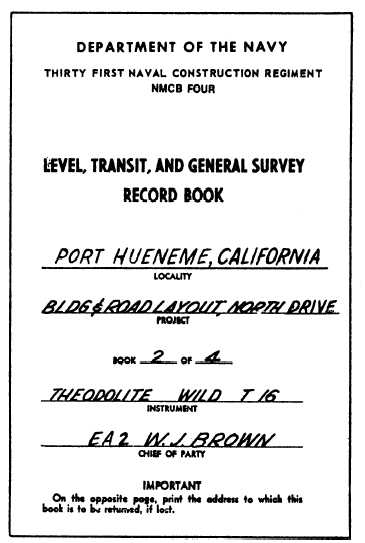APPENDIX III
SAMPLE SURVEY FIELD NOTES
The field notes contained in this Appendix are
presented to show you, the EA2 survey party chief or
the EA1 supervisor, how a series of notes are indexed
and arranged in a field notebook For completeness, the
field notes shown in appendix V of the EA3 TRAMAN
are repeated in this Appendix.
The field notes in this Appendix are samples of the
types of notes that are kept in surveying. They are not
intended to describe how the notes should be kept. That
is up to you. You are the one who decides what minimum
information is necessary to achieve complete notes, and
you are the one who decides how that information is to
be recorded. As you are well aware, note keeping is not
only an art that makes your notes clean and legible but
it is also a science that makes your notes meaningful and
correct.
Figures AIII-1 and AIII-2 are samples of the front
page and index of a notebook. The front page should be
filled out as required by your unit. A separate book
should, when possible, be kept for each major project.
The index should show all surveying projects by page
number and must be kept up-to-date at all times.
An example of recording horizontal measurements
is shown in figure AIII-3. To record taping problems,
record distance measured (by parts of tapes, if
measured) going from one station to the next. Record
in the direction in which measured; that is, down for
forward measurements, up for backward measure-
ments.
A page check of a direct-level circuit is shown in
figure AIII-4. As you recall, when page checking you
are determining that the difference between the sum of
the backlights and the sum of the forsights is equal to
the difference in elevation between the initial
benchmark or turning point and the final benchmark or
turning point. For direct-level notes exceeding one page,
the page check should always be made for each separate
page of the notes. The final page should, in addition,
show also a check from start to finish of the entire
circuit. Remember, too, that when making a page check,
you are checking only the accuracy of the arithmetic,
not the accuracy of the level shots.
Figure AIII-5 shows horizon closure for a traverse
station. In this example, each angle was repeated twice,
once direct and once reverse, using the procedures you
studied in chapter 13 of the EA3 TRAMAN for
measuring angles by repetition.
Turn all angles, direct and reverse, to the right.
Enter means, and if mean does not match single reading
to ±30", reshoot the angles. Never proceed to the next
station until horizon closure (360° ±30") has been
achieved.
Figures AIII-6 and AIII-7 show, respectively, notes
for a station-angle traverse and a deflection-angle
traverse.
Figure AIII-1.—Front page of a notebook.
AIII-1



